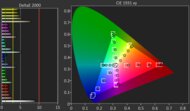- Table of Contents
- Top
- Main Differences
- Brightness
- Black Level
- Color
- Processing
- Game Mode Responsiveness
- Motion Handling
- Reflections
- Panel
- Inputs
- Design
- Smart Features
- Sound Quality
- Comments
LG C4 OLED vs Panasonic W95A
Side-by-Side Comparison
Products
Tested using Methodology v2.0.1
Updated May 29, 2025 03:43 PM
Tested using Methodology v2.0.1
Updated May 07, 2025 04:54 PM
Variants
- OLED42C4PUA (42")
- OLED48C4PUA (48")
- OLED55C4PUA (55")
- OLED65C4PUA (65")
- OLED77C4PUA (77")
- OLED83C4PUA (83")
- TV-55W95AP (55")
- TV-65W95AP (65")
- TV-75W95AP (75")
- TV-85W95AP (85")
Our Verdict
LG C4 OLED
Panasonic W95A
The LG C4 OLED is better than the Panasonic W95A in most ways. The LG displays deep and inky blacks with no blooming at all due to its nearly infinite contrast ratio, making it look better in a dark room. The LG has better accuracy in SDR without calibration and follows the PQ EOTF curve closer, making it the more accurate TV overall. Additionally, the LG displays clearer motion due to its nearly instantaneous response time, has lower input lag, and is more suitable for wide seating arrangements because of its wider viewing angle. However, the Panasonic is slightly better for bright rooms due to its better SDR brightness, and it has the edge when it comes to upscaling capabilities.













































































































































LG C4 OLED
Panasonic W95A
Comments
LG C4 OLED vs Panasonic W95A: Main Discussion
What do you think of these products? Let us know below.
Looking for a personalized buying advice from the RTINGS.com experts? Insiders have direct access to buying advice on our insider forum.